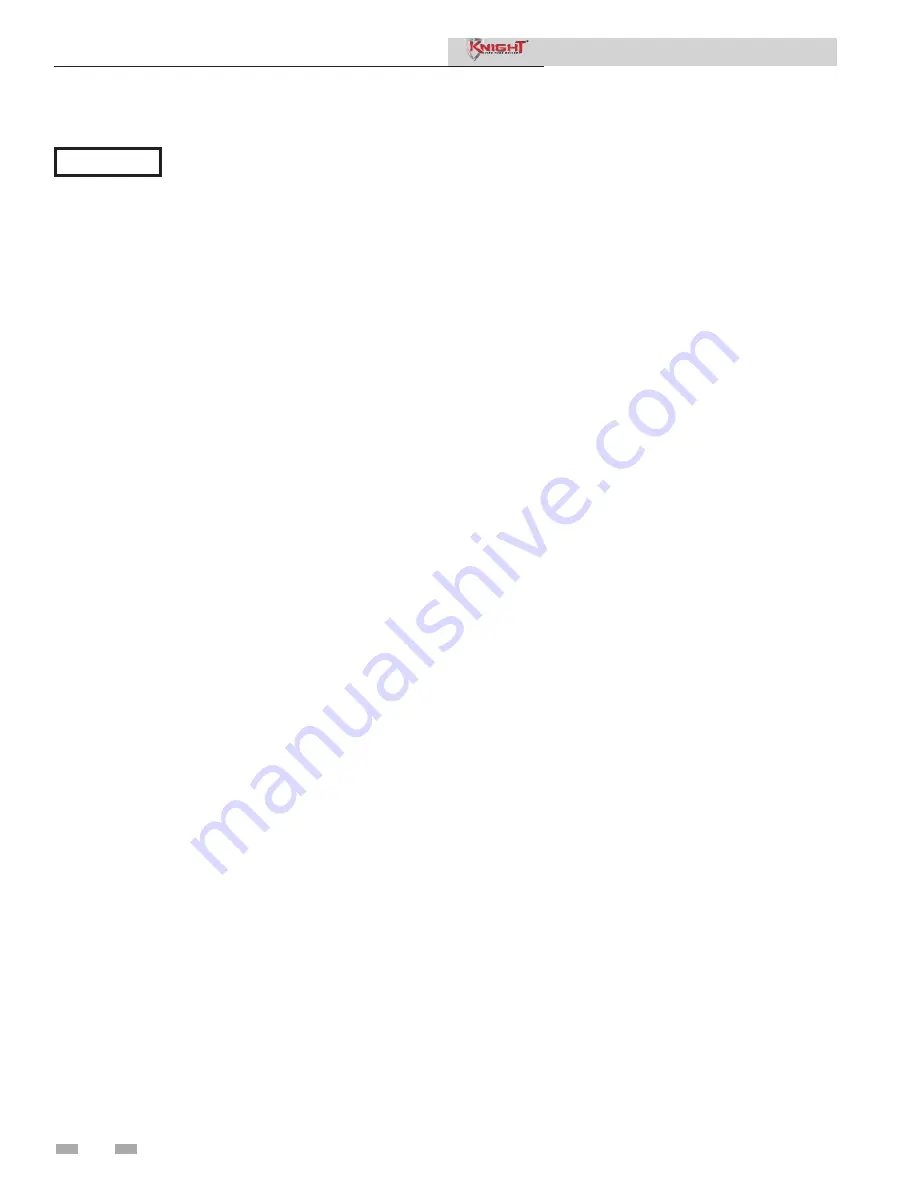
1
Service
Maximum Cascade Set Point
This parameter determines the set point used by the individual
boilers in a Cascade when a system sensor is connected to the
Leader boiler. When a boiler is commanded to fire by the Leader
boiler, it will attempt to achieve this temperature at its outlet.
The Leader boiler will limit the modulation of the boiler(s) in
order to hold the temperature at the system supply sensor to
the user set point. If any of the boiler outlet temperatures reach
the maximum cascade set point, that boiler will then modulate
down on its own in order to keep its outlet temperature within
the maximum cascade set point. Therefore, this parameter can
be used to limit the outlet temperatures of all the boilers in a
Cascade. Note that this parameter does not apply when the
boiler is heating an indirect DHW tank programmed as normal.
This parameter is adjustable by the installer by accessing the
Maximum Cascade Set Point
parameter
.
The temperature
range of this parameter is 32°F (0°C) to 190°F (88°C).
The
default maximum cascade set point is 185°F (85°C).
Cascade Offset
This parameter determines how much the temperature must
go above set point before the lead boiler will turn off. This
parameter can be adjusted by the installer by accessing the
Cascade Offset
parameter. The temperature range of this
parameter is 0° to 20°F (11°C) The default value is 10°F (6°C).
Cascade Differential
This parameter determines how much the temperature must
go below the turn off temperature (Set point + Offset) before
the lead boiler turns on. This parameter can be adjusted by the
installer by accessing the
Cascade Differential
parameter. The
temperature range of this parameter is 0°F to 60°F (33°C) The
default value is 20°F (11°C).
Cascade Type (L/L / EFF)
There are two (2) options for the way a Cascade divides the
load between its heaters. The first is Lead/Lag, designated as
L/L in the menu. This method is used when it is desired to
have the least amount of total flow through the boilers. This
method will modulate the last two (2) boilers that are firing.
This provides for smooth transitions when a boiler turns on or
off. When the last boiler reaches 100% and the calculated load
is still increasing, it will start the next boiler at its minimum rate
and reduce the previous boiler to compensate, thus eliminating
the sudden jump in total output of the Cascade. When the
calculated load is decreasing and the last boiler gets down
to minimum rate, it will hold it there and start lowering the
firing rate on the next-to-last boiler. When the next-to-last
boiler reaches minimum rate, it will turn the last boiler off
and raise the rate of the next-to-last boiler to compensate for
the decreased load, thus eliminating the sudden drop in total
output of the Cascade.
When finished, the installer can press the RIGHT SELECT
[SAVE] key to store the new settings, or the LEFT SELECT
[EXIT] key to return to the
Anti-Cycling
parameter list
without saving the changes. The delay value can be set
between 0 minutes and 40 minutes. The limit value can be set
between 0% and 100%.
Control modes
Controlling Sensor
The SH controlling sensor parameter selects the sensor the
control will use to regulate the boiler firing rate. This
parameter is adjustable by the installer by accessing the
Controlling Sensor parameter
. The sensor selections are as
follows: The outlet sensor regulates the firing rate based on
the outlet water temperature of the boiler and the inlet sensor
regulates the firing rate based on the inlet water temperature
of the boiler. If the outlet sensor is selected, and the optional
system supply sensor is connected, the control will regulate the
firing rate based on the system supply sensor temperature. The
default sensor is the Outlet Sensor.
Cascade Address
The boiler designated as the Leader needs to be programmed
with address 0. All the Member boilers require addresses
from 1 to 7, and the addresses must be different for each
Member. The addresses can be in any order, regardless of the
order in which the units are wired together. This parameter
is adjustable by the installer by accessing the
Cascade Address
parameter. The outdoor air (if used) and system supply sensor
must be connected to the Leader boiler. The default address
is 1.
Ramp Settings
The SMART SYSTEM control can be programmed to limit
the firing rate for a fixed period of time at the start of a space
heating or BMS set point demand. There are six (6) possible
limits, each with their own time delay. The first limit applies
as soon as the burner starts. Once its time delay expires, the
second limit is applied and its timer begins. The control steps
through these limits until the 6th (sixth) limit expires. Note,
however, that the 6th limit will also limit the rate for the rest of
that heat demand. The installer can adjust the firing limits and
time delays by accessing the
Ramp Settings parameter
. Once
this parameter is selected, the screen will show the step number,
the time delay for that step and the limit value corresponding
with that step. If the installer wishes to adjust one of the values
in that step, he can press the NAVIGATION dial until the value
he wishes to change is flashing. The installer can then rotate
the NAVIGATION dial to adjust that value. If the installer
presses the RIGHT SELECT [SAVE] key while the limit value
is flashing, the step value will flash again. The installer can
then select the next step and adjust the delay and limit values
corresponding with that step.
Please note that the brackets ([]) denote
screen status.
NOTICE
26
Service Manual
Содержание 100 Series
Страница 51: ...51 Service Manual Notes ...






























